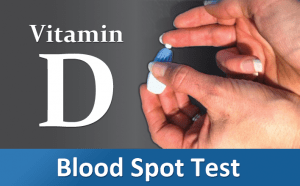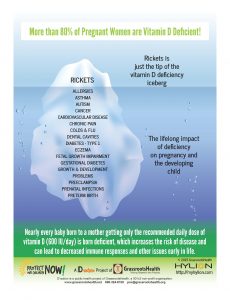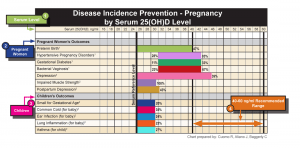Published on August 8, 2017
It typically takes 17-30 years for research to become practice.
Why? Because a hospital would have to create this initiative from scratch – create a plan; cull the research; design software; define the data they need to collect; create a pilot program; analyze the data from the pilot; assess the program; and so on. If successful, the program then would move to a broader scope within the hospital.
They no longer have to do that alone.
GrassrootsHealth is in the business of finding scientific research consensus and then moving that research into practice as quickly as possible. Since our founding in 2007, we developed and implemented that methodology. We now have a proven translational approach to vitamin D and pregnancy. We can implement it at any willing hospital because we have the tools and methods ready to go.
The Background – Why Vitamin D?
 GrassrootsHealth was founded by Carole Baggerly, after her recovery from breast cancer and breast cancer treatment. When she found out a researcher, Dr. Cedric Garland of UCSD had already been working 20 years on getting the word out that vitamin D levels between 40-60 ng/ml (100-150 nmol/L) could reduce breast cancer she was floored! Why doesn’t everyone know this?
GrassrootsHealth was founded by Carole Baggerly, after her recovery from breast cancer and breast cancer treatment. When she found out a researcher, Dr. Cedric Garland of UCSD had already been working 20 years on getting the word out that vitamin D levels between 40-60 ng/ml (100-150 nmol/L) could reduce breast cancer she was floored! Why doesn’t everyone know this?
Well, if no one was going to tell her, she would tell other people.
And GrassrootsHealth was born.
Vitamin D Consensus
In 2007-2008 Carole traveled throughout the US and Canada learning from vitamin D researchers and developing a Public Health Call to Action, which 48 vitamin D scientists have signed, based on the consensus that vitamin D levels of 40-60 ng/ml (100-150 nmol/L) could significantly prevent disease. Our disease incidence prevention chart was created to highlight this fact. This goal has not changed since 2007. All 48 scientists are in agreement. This is no small feat!
 D*action
D*action
In 2009 D*action was born. At this time doctors would not reliably order vitamin D tests, even if directly asked by their patient. D*action provided a means for individuals to test their own vitamin D levels, information about the benefits of vitamin D, as well as a basis for research. Since that time, D*action has grown over 10,000 participants strong and GrassrootsHealth has published a number of several peer-reviewed research papers.
Breast Cancer Prevention Project
Multiple studies have shown that raising vitamin D levels to the recommended range of 40-60 ng/ml (100-150 nmol/L) could reduce the incidence of breast cancer by 50-80%. In 2014 GrassrootsHealth created a field trial to test this hypothesis. It was funded by the Vitamin D Society in Canada and Bio-Tech Pharmacal. Women 60 years or older, with no current cancer, and not currently being treated for cancer are allowed to join. This free field trial monitors their vitamin D blood levels and health condition every 6 months for 5 years.
Two-year results were published in PLOS ONE, April 2016, entitled – Serum 25-Hydroxyvitamin D Concentrations ≥40 ng/ml Are Associated with >65% Lower Cancer Risk: Pooled Analysis of Randomized Trial and Prospective Cohort Study.
Vitamin D and Pregnancy
While cancer remains the #1 concern for many of our followers, research came to light in 2011 suggesting that vitamin D could prevent preterm birth. Not only is this a significant problem in the US, it is time bound. Cancer studies can take years, and often do not show clear results. Preterm birth can be studied in a much shorter time frame and the results are clear – a baby is either born before 37 weeks or after.
In 2012 Protect our Children NOW! was born. This project is centered around vitamin D testing and acheivement of at least 40 ng/ml (100 nmol/L) in pregnancy.
In 2015 we signed on our first hospital, the Medical University of South Carolina, to run this project. We provided them with a full methodology which had taken over seven years to develop.
In 2017, GrassrootsHealth published data from the first 2-year Protect our Children NOW! project. Vitamin D was shown to be safe and effective in preventing preterm birth (40-60% lower risk).
Within Pregnancy, Are There Other Benefits Besides Preterm Birth?
Most women of childbearing age are vitamin D deficient. If vitamin D is helpful for the baby’s development – and lung and brain development starts during weeks 4-6 gestation – then wouldn’t it make sense that pregnant women would want to have sufficient vitamin D for both herself and her baby as soon as possible?
Yes!
Below are just two charts that explain how vitamin D in pregnancy can lead to a better life for the child.
World-Wide Action Plan
Start with Yourself
Educate yourself today. Read about the benefits of vitamin D for general health or specific conditions such as breast cancer and diabetes.
Test – do you think you are at the recommended levels? The only way you can know is to test, not guess. Order your at-home test here, or go to your doctor and ask for a 25(OH)D test. Do not take no for an answer and don’t accept, “Your vitamin D level is fine.” Get the actual number and compare it with what 48 vitamin D scientists recommend and our disease prevention chart. Is your vitamin D level helping to prevent disease?
Tell all who will listen! Write a blog. Make a vlog. Write a post on Facebook. Send emails to family. Talk to your friends. Help us get the word out that vitamin D is important for your health.
Expand to the Hospitals
Donate today – Help us start these new hospital programs. Grant funding for nutrients, such as vitamin D, is rare. The money is not in nutrients, but drugs. You can help fund these hospital nutrient programs, and during August your contribution is doubled with Dr. Joseph Mercola’s offer to match all donations up to $25,000. If you are a foundation or philanthropist and want to partner with us please contact [email protected].
Expand to Communities at Large
Donate today – There is much to be done with all members of a community. If you would like to help organize a community event, please contact [email protected].

 D*action
D*action

